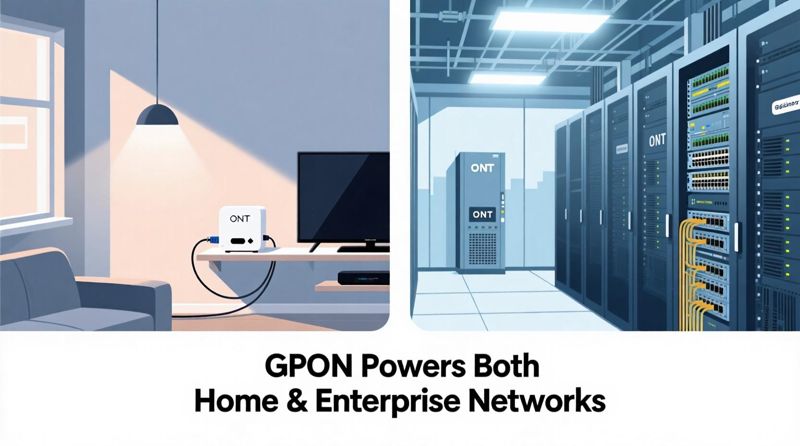Cable & Wire | High quality and excellent service at reasonable prices.
info@zion-communication.com
Author: James Publish Time: 12-08-2025 Origin: Site
The ubiquitous use of ultra-fast and highly reliable internet connections is a key factor in the widespread adoption of GPON (Gigabit Passive Optical Network) technology globally. It enables high-speed data transmission over fiber optic cables, ensuring gigabit-level broadband speeds to homes, businesses, and enterprises with high efficiency and low operational costs.
In this article, we will explore what GPON is, how it works, its advantages, applications, and common questions, which will surely augment your knowledge of this indispensable technology within the telecommunications system.

GPON, a point-to-multipoint access technology that utilizes passive optical splitters to share an optical fiber to multiple users at a gigabit data rate, is an acronym derived from Gigabit Passive Optical Network. It is used as a member of a Passive Optical Network (PON) family, operating at downstream speeds of 2.488 Gbps and upstream at 1.244 Gbps.
Unlike traditional active circuits, GPON utilizes passive optical components (i.e., those that do not require a power supply), thereby reducing equipment investment and simplifying its complexity.
GPON consists of three main components:
OLT (Optical Line Terminal): A part of the provider's network, it acts as the endpoint of the optical network. Tasked to manage the information transmission and control multiple endpoints.
Optical Splitters: Passive devices that help take the optical signal and create a similar kind of signal for other fibers, thus allowing those other fibers to serve many users as if one fiber is serving them all.
ONT/ONU (Optical Network Terminal/Unit): The customer equipment that converts optical signals into electrical ones to be used by end-user devices.
Downstream: The OLT accomplishes broadcast to all targets as TDM (Multiplexing Time Division) is employed instead of data addressed to each endpoint individually, but carrying encrypted data so that each ONT can access what is theirs only.
Upstream: The ONTs send packets back to the OLT in their separated time slots by TDMA (Time Division Multiple Access), preventing packets from merging.

High Bandwidth: Extend up to 2.488 Gbps (downstream) and 1.244 Gbps (upstream) rate.
Cost-Effective: Passive optics eliminate the need for electrical power for equipment in the field which in turn reduces field maintenance and energy costs respectively.
Scalability: Growth is generating through splitting capacity of the fiber, within which multi-users up to 64 or more will be connected.
Long Reach: GPON works distances of up to 20 km without active repetition.
Quality of Service (QoS): Provides support for multiple service types (voice, video, data traffic) along with traffic prioritization.
Secure and Reliable: Through cryptography and authentication, such secrecy of the crucial data is assured.
Fiber-to-the-Home (FTTH): The provision of gigabit broadband for residential customers.
Fiber-to-the-Building (FTTB): The function of trading or entrepreneurship in multiple dwellings or business premises is provided by using fiber.
Enterprise Networks: Fiber optics communications giving you speed, scalable, and high-bandwidth connection across multiple campuses and enterprise organizations.
Mobile Backhaul: Gigabit-level connects mobile base stations with fiber for having better bandwidth and latency.
Smart Cities and IoT: Deploying various types of large-scale sensor networks and data processing undertakings.

Technology | Downstream Speed | Upstream Speed | Typical Split Ratio | Max Distance | Notes |
GPON | 2.488 Gbps | 1.244 Gbps | Up to 1:64 | 20 km | Most widely deployed today |
EPON | 1.25 Gbps | 1.25 Gbps | Up to 1:32 | 20 km | Ethernet-based PON |
XG-PON | 10 Gbps | 2.5 Gbps | Up to 1:64 | 20 km | Next-gen GPON technology |
NG-PON2 | 40 Gbps (aggregate) | 10 Gbps | Up to 1:64 | 20 km | Multi-wavelength PON |
Take care of all the ends of fiber connectors and cables to ensure cleaning and no damage to signal loss.
Properly set up OLT and ONT devices as per ISP's standards.
Use endorsed optical splitters and high performance devices that can pass a set of tests.
Consistently check power levels of the optics to detect defective fibers quickly.
Take proper measures to protect fiber and equipment from the environment such as sunshine.
A: Both sides of the coin. The technology GPON is mainly used for residential FTTH services and enterprise fiber solutions due to its efficiency and high bandwidth.
A: To the extent of around 20 kilometers without the active repeaters intervention subject to quality of the fiber and frequency of the splitter.
A: Yes, GPON can take it all. GPON is capable of delivering all service types at once with the help of QoS.
A: An OLT at the provider and optical splitters in distribution network, and as well ONT/ONU device at the customer premises.
A: GPON employs TDM and GEM encapsulation with a speedy downstream, while EPON is Ethernet-based using symmetrical speed, often meant for Ethernet networks' compatibility.
A: Absolutely. When it comes to higher bandwidths and performance, approaches such as XG-PON and NG-PON2 offer the required improvement while being backwards compatible.
GPON is ground-breaking technology which supports the modern fiber optic broadband networks and is based on high speed, low cost, and excellent scalability. By having GPON as a basis for residential internet, enterprise connectivity, or smart cities infrastructure confidence, the end user and service provider can further improve its performance and expansion options.

James is a technical manager and associate at Zion Communication.
Specializes in Optical Fiber communications, FTTH Solutions,
Fiber optic cables, ADSS cable, and ODN networks.
james@zion-communication.com
+86 13777460328
